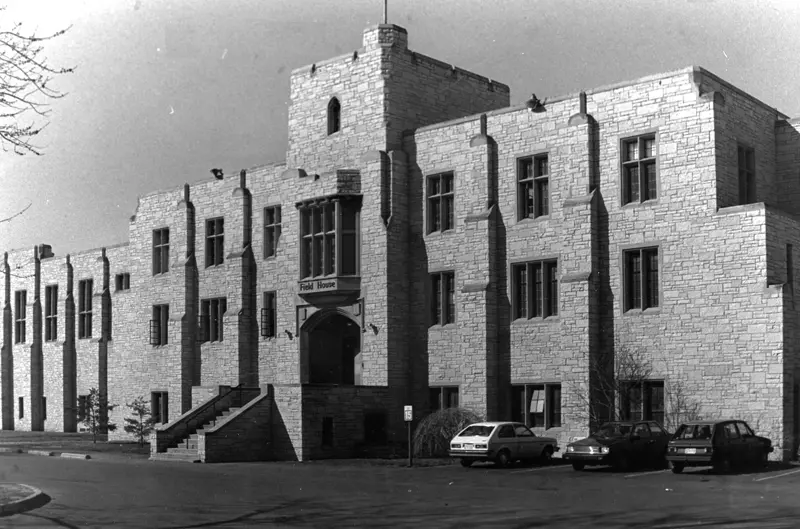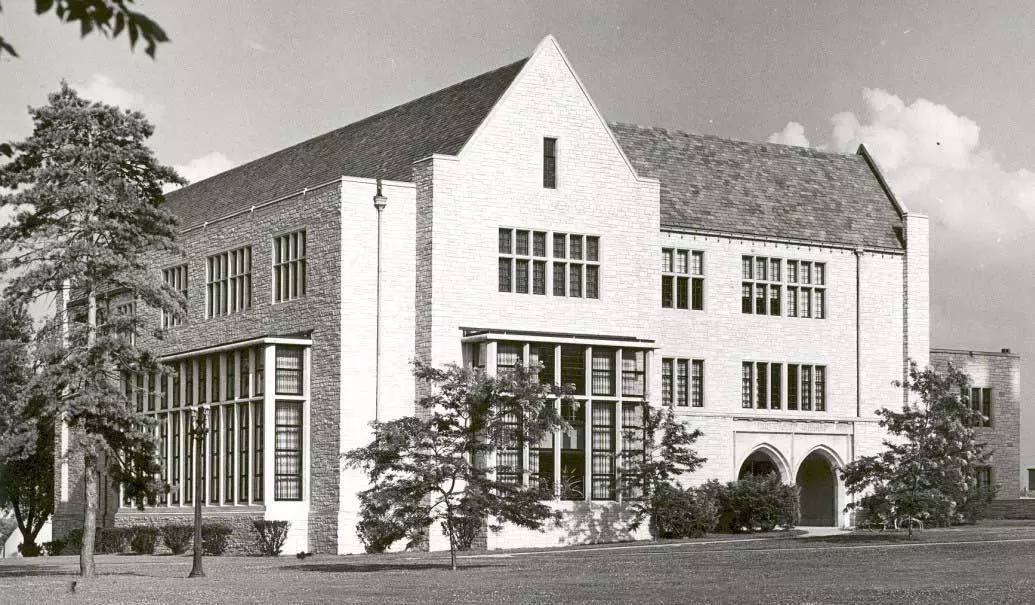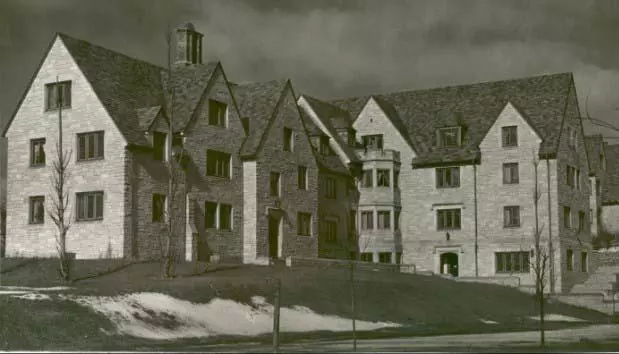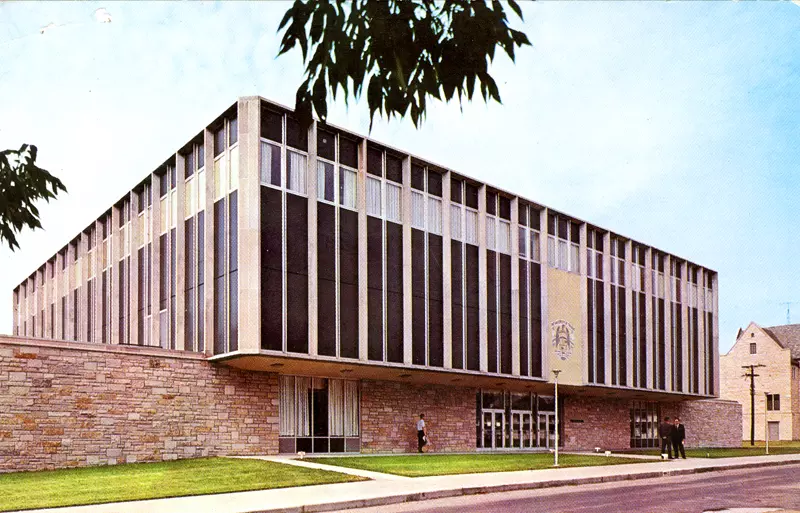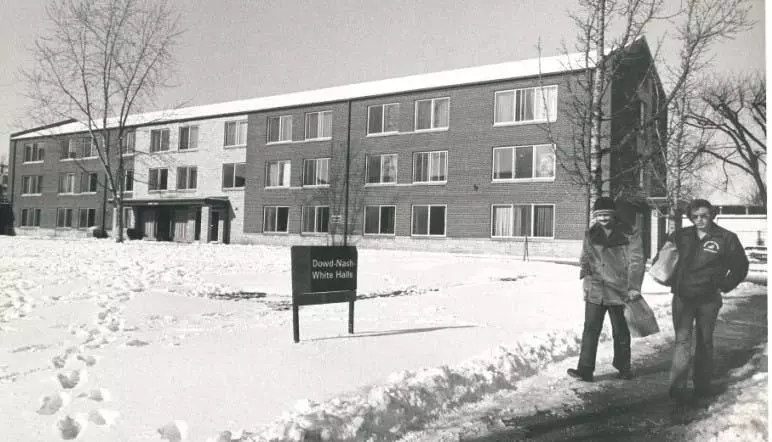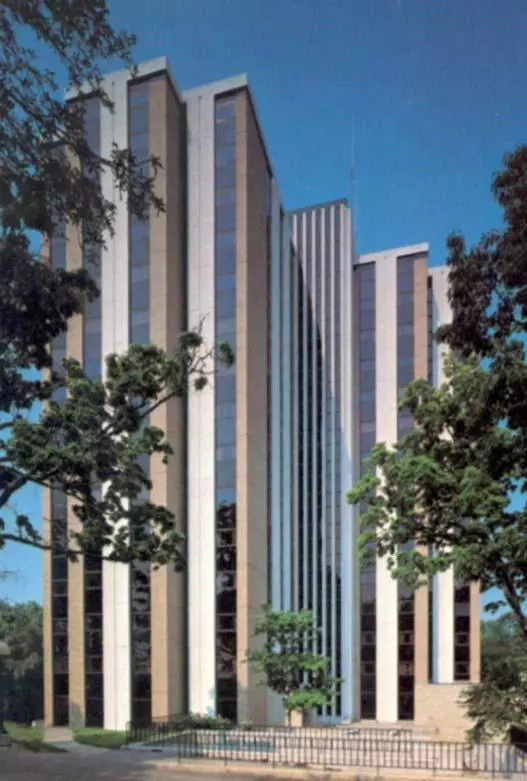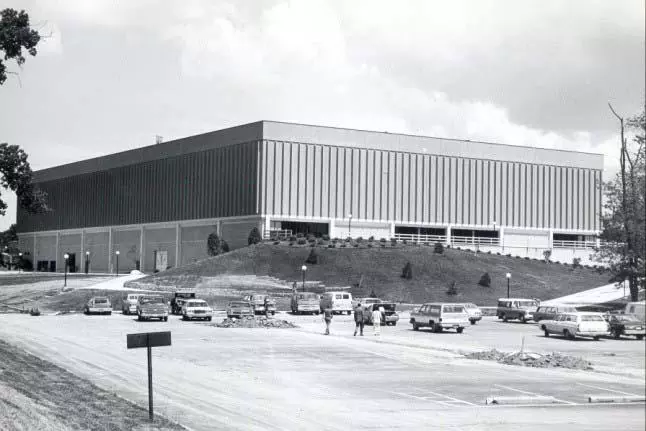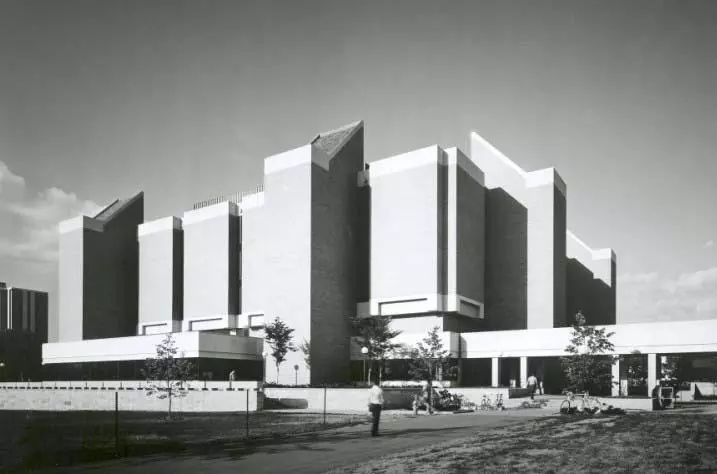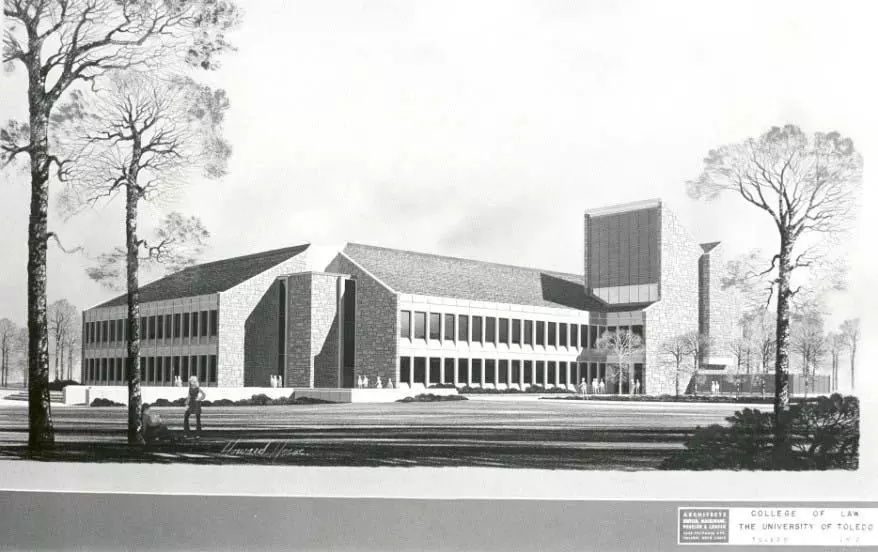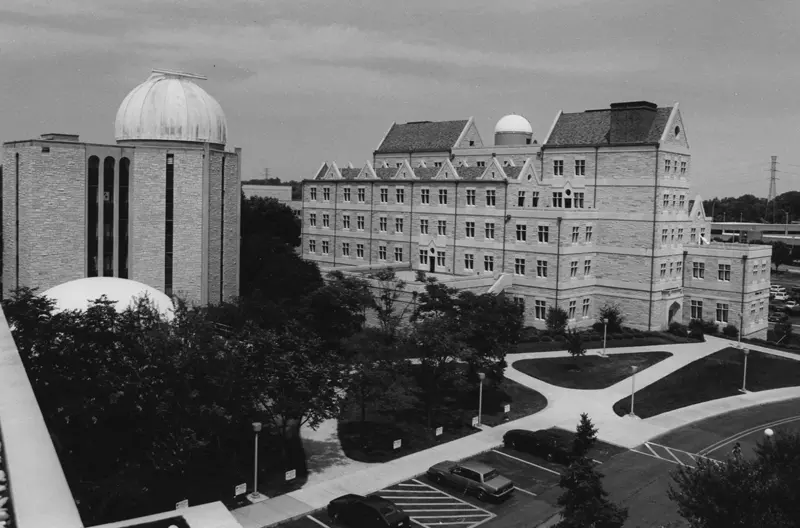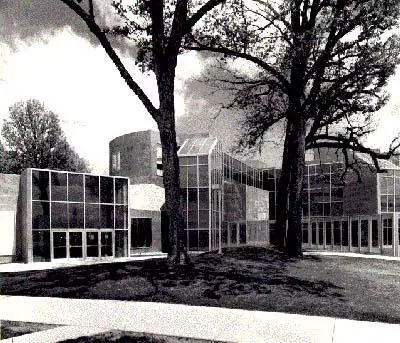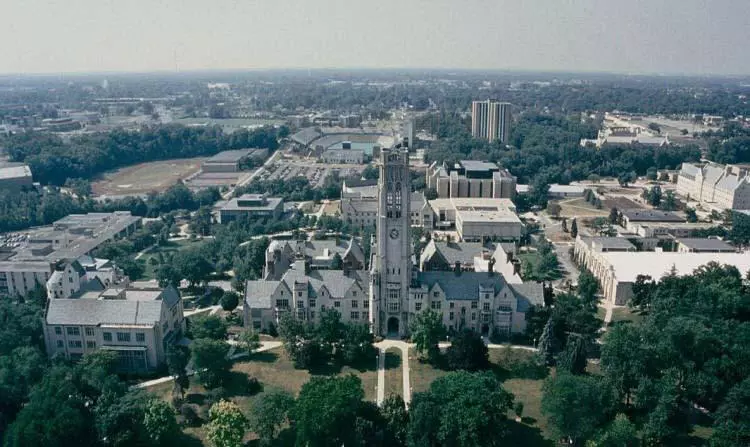 Aerial View of the University of Toledo Campus
Aerial View of the University of Toledo Campus
Exhibit Gallery

























by Barbara Floyd
"...We believe you are going to respond to the challenge of a beautiful environment, that the traditions which have grown up about this noble architecture will stimulate you to greater efforts in learning, and to finer decorum, and to a deeper resolve to use your education to further truth, justice and beauty. This is our faith in you." UT President Henry J. Doermann, 1931, on the University's move to the new campus on Bancroft Street.
This virtual walking tour of the University of Toledo provides an overview of the campus's architecture. The University's Bancroft Street campus dates to 1931, when the institution moved from several temporary buildings scattered around the city to a location adjacent to a beautiful, tree-lined residential neighborhood in west Toledo. The university's president at that time felt that the architecture of the campus should be inspiring to students. Today the university's buildings represent a microcosm of architectural movements since the 1930s, and include outstanding examples of Collegiate Gothic, International, Transitional, and Post-Modern styles. Despite being of many styles, the campus presents a unique uniformity in the design through the consistent use of similar building materials and architectural elements.
Since the creation of the original tour in 1997, much has changed within the University of Toledo and its architecture. This project is currently ongoing, with new photos and history in the works for addition to the exhibit. An exhibit on the history of The University of Toledo Health Science Campus (formerly the Medical University of Ohio) is also forthcoming soon.
An excellent history of the university, through aerial photography, has been created by the Department of Geography and Planning.
Collegiate Gothic Style
The Gothic style was promoted by architect Ralph Adams Cram for college campuses of the early 20th century. As Cram wrote in 1914, Collegiate Gothic "return(s) step by step to the old ideals and sound methods of English colleges...return(s), even in a wider sense, to those eternally battered but eternally enduring principles in life and thought and aspiration which make up the great Anglo-Saxon heritage."
Cram's Gothic Revival movement was inspired by the same ideals that fueled the great Gothic movement of the 12th century. Like his earlier counterparts, Cram saw Gothicism as a revolt against the symmetry, order and simplicity of classicism. Cram had great disdain for the three evils "Reformation, Renaissance, and Revolution" and disliked the classical and secular academic architecture embodied by Thomas Jefferson's University of Virginia. He believed art, religion and education were inseparable. Cram himself designed college buildings at Princeton and West Point and inspired similar works at the University of Chicago and Duke University. Clearly his work had great influence on the Toledo firm of Mills, Rhines, Bellman and Nordhoff, Inc. and its University Hall design.
1. University Hall
Architects: Mills, Rhines, Bellman, and Nordhoff, Inc., Date Completed: 1931, Cost: $2 million
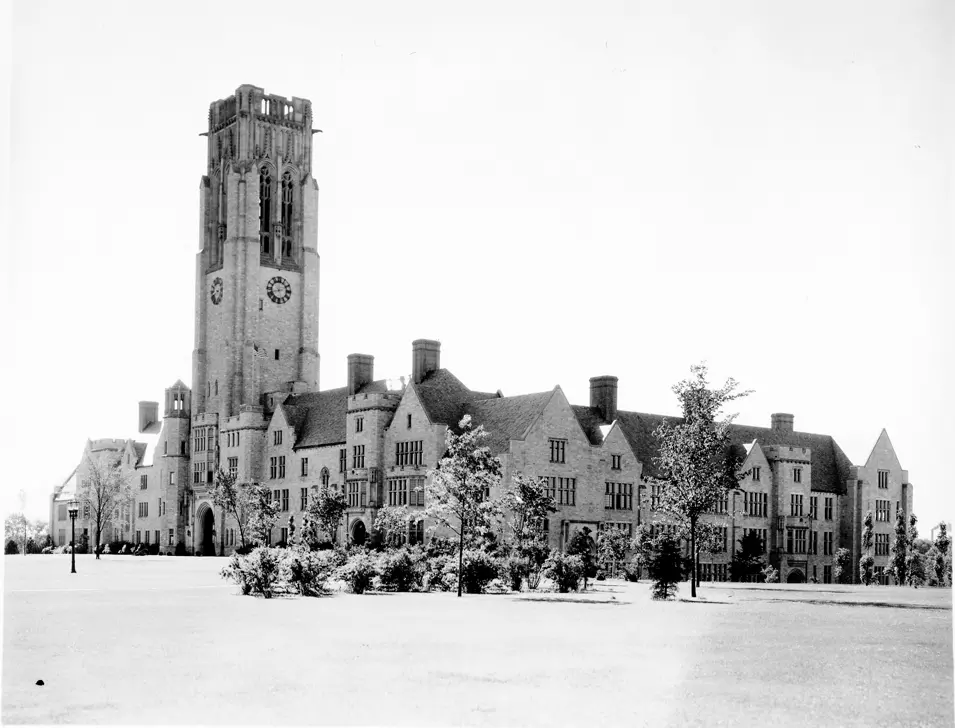 University Hall in 1936
University Hall in 1936 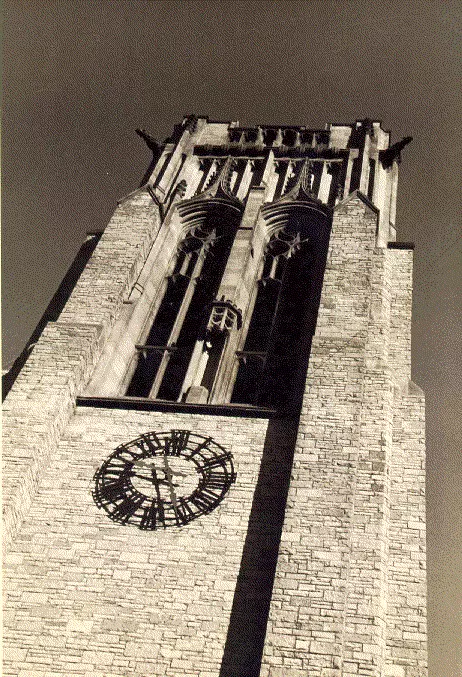 University Hall Tower
University Hall Tower
To many, University Hall is The University of Toledo. Since its completion, it has been one of the most recognizable structures in Toledo. The first building on the new campus, it is one of the best examples of the collegiate brand of Tudor Gothic Revival in the country.
University Hall was built by 400 men in 11 months. It is constructed from 50,000 tons of Wisconsin Lannon and Indiana limestone, the same building materials used in almost all UT buildings from that time on. The building is 63 feet tall, complemented by an impressive 205-foot tower. Since its construction, the building has undergone extensive interior renovation, but its exterior has changed little.
Features to note:
- Asymmetrical front facade. Typical of the Romantic's rebellion against order.
- Pointed arch doorways. Similar to the Gothic cathedrals of Europe.
- Battlements. This cut-out roofline design on the small flanking towers is similar to the design used in English castles for defense purposes.
- Stone lace-like ornamentation. The stonework at the top of the tower is similar to that adorning the spires of Europe's cathedrals.
- Statuary niches. The building has numerous niches for statues like those used for religious icons in churches. There is no evidence that statues were ever made for these niches.
- Ornamentation. Symbols of the branches of learning (music, literature, mathematics, and pharmacy) are carved in the doors of the main entrance immediately above, and the blockhouse symbolized UT's connection to the City of Toledo. Gargoyles like those used to ward off evil spirits in cathedrals adorn numerous nooks, including four that protrude from the tower 200 feet above the entrance. Numerous romanticized symbols on the ceiling outside and leaf-like ornamentation inside Doermann Theater should be noted.
- Main entrance doors. Modeled after Dareway Hall, a 16th-Century English mansion.
- Courtyards like those in the east and west wings of the building are common in European universities.
2. Field House
Architects: Mills, Rhines, Bellman and Nordhoff Inc. Date completed: 1931. Cost: $470,000
The second building on the new campus, the Field House served as the gymnasium. While primarily utilitarian, it displays some of the same Gothic feature s as University Hall. In addition to being used for physical education classes, the Field House has been used for the University's basketball games; as a concert hall; and for large assemblies, including commencement ceremonies. After the opening of Centennial Hall (now Savage Hall) in 1976, the Field House was largely unused and in need of repair. The building underwent a complete renovation in 2008 and now houses classrooms, faculty offices, an auditorium, and an educational incubator.
Features to note:
- Battlements along roof lines.
- Tower-like entryway. The entrance appears almost as a shortened University Hall tower.
- Protruding supports. If these supports surrounding the building were extended outward, they would look like the flying buttresses used to support the great Gothic cathedrals of Europe.
- Central bay window. Bay windows are common Gothic features.
3. Scott, Libbey, and Tucker Halls
Architects: Gerow and Conklin. Date completed: 1935. Cost: $250,000
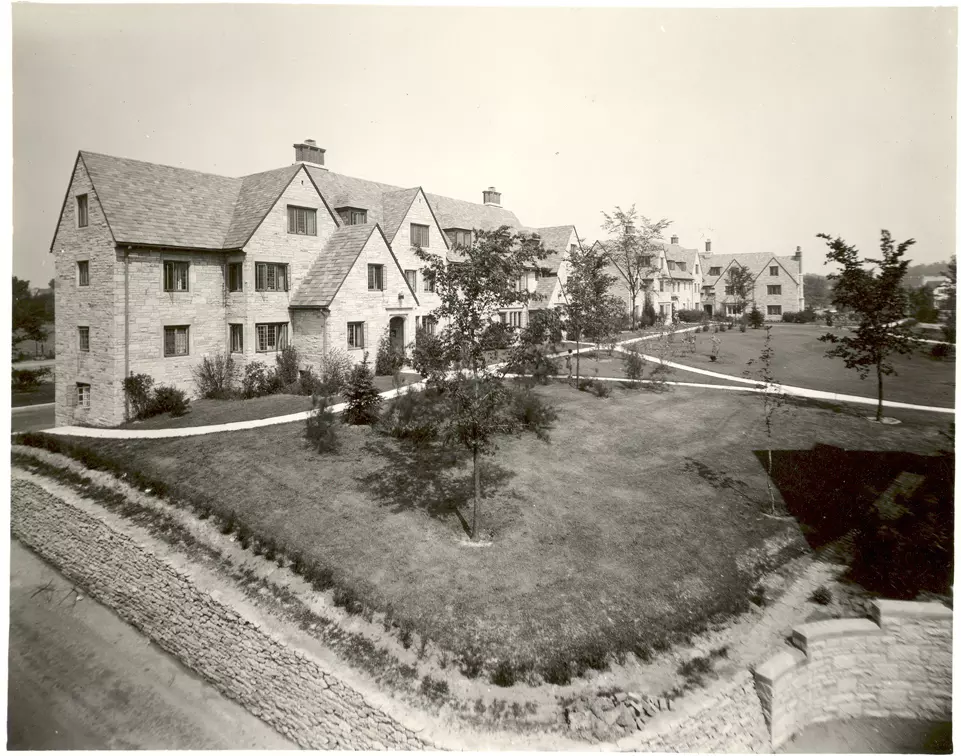 Scott and Tucker Halls
Scott and Tucker Halls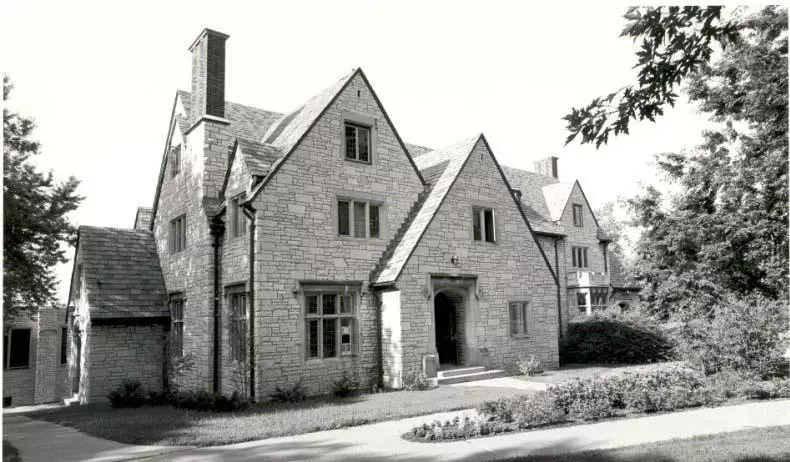 Libbey Hall
Libbey Hall
The first residential buildings on campus were, coincidentally, designed by an architectural firm know primarily for its residential structures. Gerow and Conklin designed many of the homes in the Old Orchard and Ottawa Hills areas. The funds for construction came from the government's Federal Emergency Relief Administration, and work was done by Works Progress Administration employees. Scott and Tucker halls housed faculty and the University president. Later the buildings were used by sororities and fraternities. Libbey Hall was built as the first Student Union, with the top floors serving as a dormitory. The buildings are now used for offices and the University Club in Libbey Hall.
Features to note:
- Slightly pointed arched doorways.
- Tudor-like half timbering.
- Residential-like design. Unlike the "great building" design of University Hall and the Field House, Scott, Libbey and Tucker look much like homes. The peaks of the roofs slope near to the ground, bringing the buildings closer to human proportions.
- Pointed dormer windows.
- Small tower-like protrusions on Scott and Tucker.
4. Gillham Hall
Architects: Bellman, Gillett, and Richards. Date Completed: 1953. Cost: $1.5 million
Opposite the Scott, Tucker, and Libbey complex on the front campus green is Gillham Hall. While built some 20 years after the first UT structures, it continues the Gothic tradition in many ways. However, the modern influence is beginning to be seen with simpler, cleaner lines; less ornamentation; and a growing emphasis on the horizontal over the vertical. Built to house the University library and College of Law, today the building is primarily used for University offices.
Features to note:
- Peaked roof design is seen in some areas, but flat roofs are becoming more prominent.
- Pointed archways reflect Gothic tradition.
- Bay windows remain as a design element, but have been simplified. The sides are not angled.
Other Buildings of the Collegiate Gothic Style
Glass Bowl Stadium (old section)
Architects: Gerow and Conklin. Date Completed: 1937. Cost: $335,000
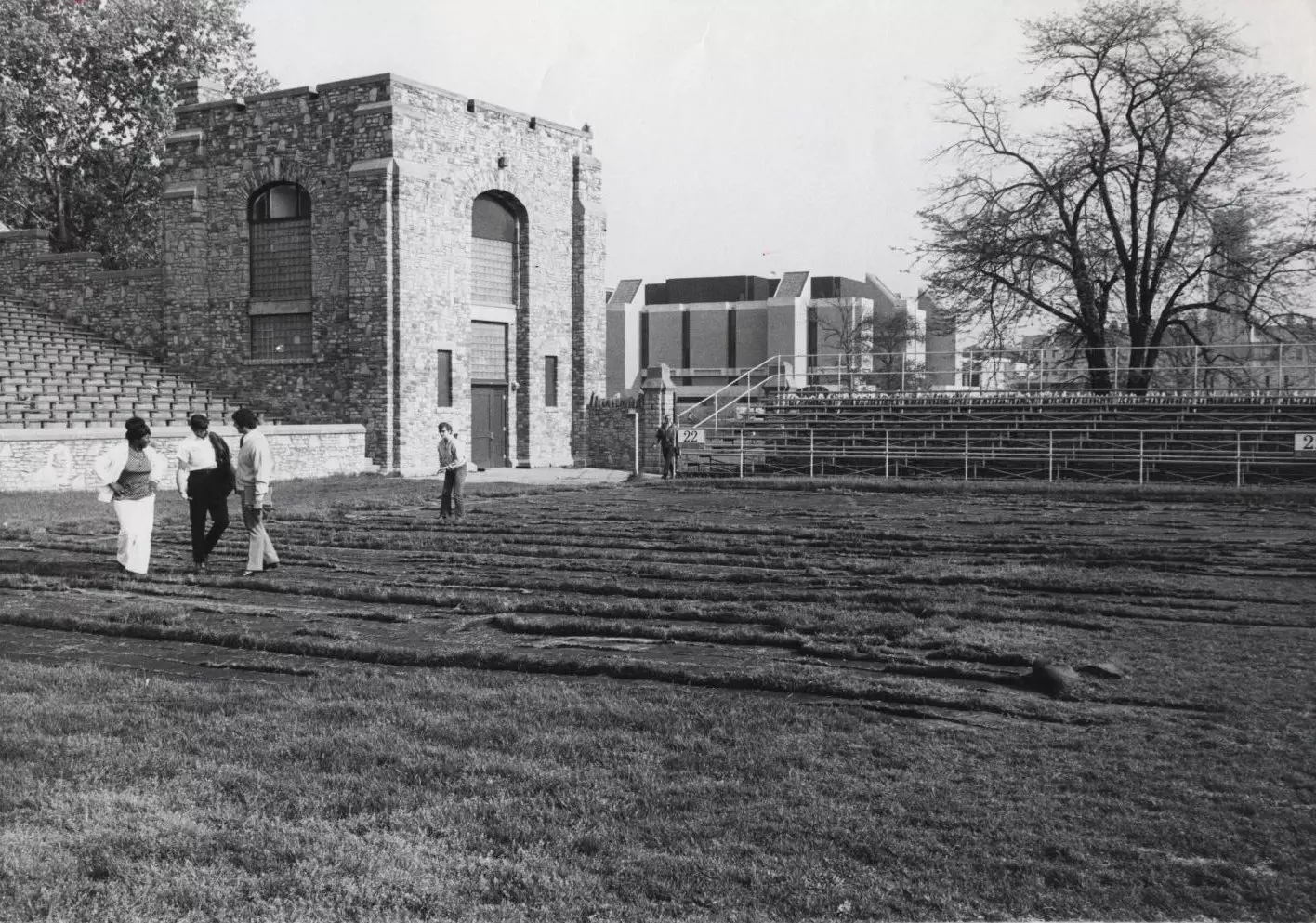 Glass Bowl Stadium (old section)
Glass Bowl Stadium (old section)
MacKinnon Hall (old section)
Architects: Gerow and Conklin. Date Completed: 1939. Cost: $160,000
Student Union (old section)
Architects: Bellman, Gillett and Richards. Date Completed: 1959. Cost: $1 million
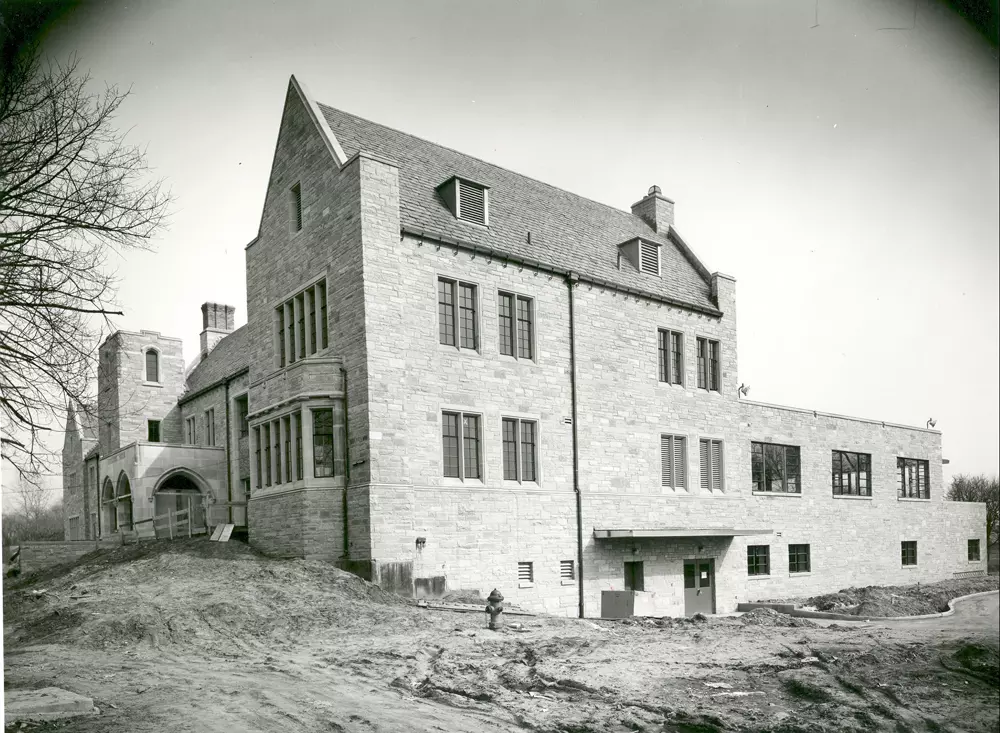 Student Union, September 22, 1959 (old section)
Student Union, September 22, 1959 (old section)
International Style
International Style dates to 1932 when the Museum of Modern Art exhibited the works of modern architects from 15 different countries, all showing similar design elements in their work. The critics dubbed the style "Internationalism" because its features seemed to cross national boundaries. This style was based upon straight planes. While the style is often used in skyscrapers, horizontal space is as important as vertical. Functionalism, simplicity, balance, regularity, and flexibility in planning were also components of this style.
5. Engineering-Science Building
Architects: Bellman, Gillett, and Richards. Date Completed: 1960. Cost: $2 million
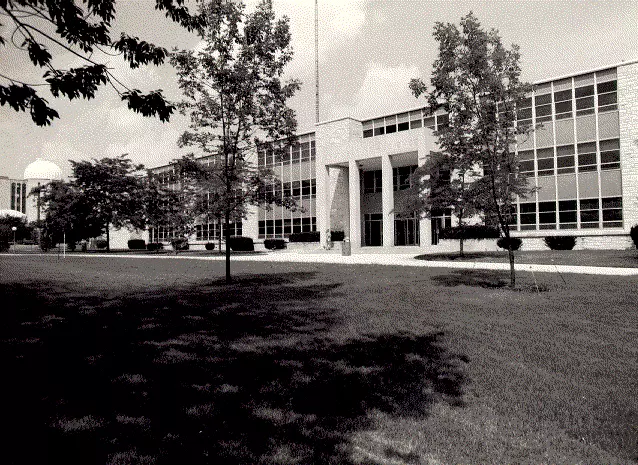 Engineering-Science Building
Engineering-Science Building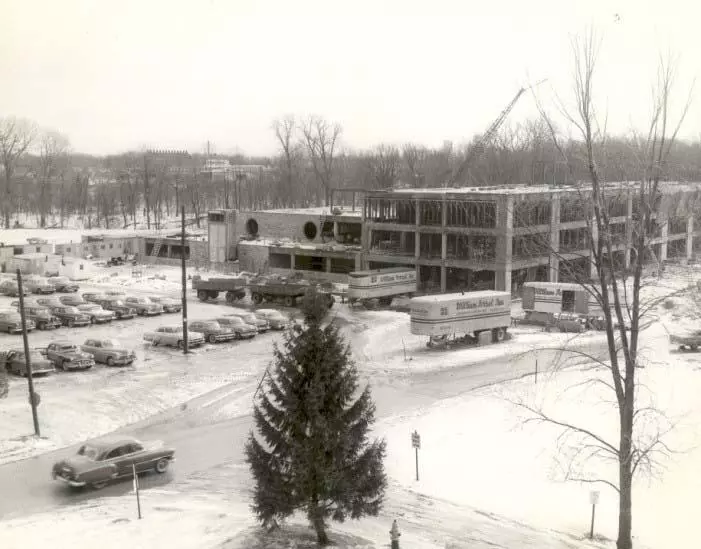 Engineering-Science Building During Construction
Engineering-Science Building During Construction
Designed by the same firm and only one year apart, the Student Union and the Engineering-Science Building differ greatly in style. The Engineering -Science Building is the first UT academic building to completely abandon the Gothic tradition in favor of the International Style. It seems natural that a building dedicated to teaching the newest technology would have a structure of modern design. The Engineering-Science Building reflects America's desire for education to move ahead in the post-Sputnik era, severing ties to history and the Gothic World.
Features to note:
- Flat roofs have entirely replaced peaked ones.
- Glass and steel are prominently used on the facade.
- There is no unnecessary ornamentation.
- The building is symmetrical in layout.
- The four front columns are devoid of ornamentation.
- The Dana Auditorium addition is circular, showing mechanical and geometric influence.
- Later additions to the building continue the International Style, with flat, sleek surfaces.
6. Snyder Memorial
Architects: Richards, Bauer, and Moorhead. Date Completed: 1964. Cost: $1.69 million
With the post-Sputnik emphasis on education, it was necessary to educate more teachers. Snyder Memorial, built with an endowment from Walter and Grace Snyder, is home for the College of Education and Allied Professions. It is an excellent example of the 1960s brand of Internationalism.
Features to note:
- Sleek black glass and steel are the prominent building materials.
- The top portion of the building is larger than the base. This is another common element of Internationalism, showing that modern structural design could allow a heavy top to be supported by a smaller base.
- Flat roofs.
- The vertical planes are emphasized over the horizontal, following the skyscraper model.
Other Buildings of the International Style
Dowd-Nash-White Quadrangle
Health Education Center
Architects: Britsch, Macelwane, Poseler and Lubeck. Date Completed: 1969. Cost: $1.6 million
Parks Tower
Architects: Schauder and Martin. Date Completed: 1971.Cost: $7.1 million
Student Union (1972 addition)
Architects: Richards, Bauer, and Moorhead. Date Completed: 1972. Cost: $3.6 million
Transitional Style
The buildings of the late 1960s and 1970s exhibit features associated with several styles. They are transitional between the extremes of the International Style and the new look of the Post-Modern Style. They include elements of the New Formalism, a style promoted by Minoru Yamasaki, who designed the buildings on the Medical College of Ohio campus. Other influential figures of this transitional period include Charles-Edouard Le Corbusier and Philip Johnson. All were reacting against the severities and the programmed look of the International Style as seen in structures such as the Engineering-Science Building and Snyder Memorial. These transitional buildings are typified by the combination of geometrical shapes to form structures. There is less interest in flat surfaces and more on round. Another common feature of this period is the use of a series of tall rounded colonnade archways. Absolute symmetry is replaced with varied shapes balanced against one another.
John F. Savage Hall
Ritter Astrophysical Research Center
Architects: Richards, Bauer, and Moorhead. Date Completed: 1967. Cost: $1 million
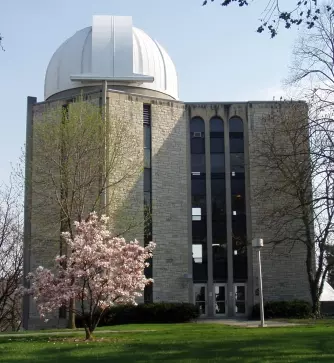 Ritter Astrophysical Research Center
Ritter Astrophysical Research Center
Of the four academic buildings built in the 1960s three housed the sciences. Ritter Astrophysical Research Center reflects many transitional elements between strict Internationalism and New Formalism.
Features to note:
- Use of glass and steel less prominent than in the Engineering-Science or Snyder Memorial buildings, although colored panels are used to separate the floors in a way similar to the other buildings.
- The tower portion housing the telescope is slightly rounded with cog-like protrusions, showing a mechanization and geometrical influence.
- Strict symmetry is replaced by varied yet balanced elements.
- The series of tall, rounded archway decorations is common in New Formalism.
William S. Carlson Library
Architects: Munger, Munger, and Associates. Date Completed: 1973. Cost: $8 million
Carlson Library begins a trend back to the Gothic tradition in UT architecture. While showing some International Style components, it has obvious elements of Gothicism as well. There was a conscious effort by the architects to incorporate slanted roofs and Gothic towers in the design. The Law Center, constructed at the same time, reflects similar transitional elements. Geometrical shapes are important parts of both buildings.
Features to note:
- Eight protruding towers, showing the Le Corbusier interest in combining geometrical shapes.
- Slanted roofs on towers, showing both an interest in geometry and a throwback to Gothicism.
- Separation of buildings into sections and towers at corners help create vertical feeling to balance the horizontal bands of color.
Other Buildings of the Transitional Period:
Law Center
Center for Performing Arts
Post Modern Style
Post-Modern is the name given to recent developments in architecture. Its defining elements are not always clear, but it does represent a drastic change from the buildings of the International Style. For some architects, Post-Modern is a return to the styles of the 1920s and 1930s. To others it means an interest in the arbitrary geometry of the Beaux-Arts school of the 19th century. To still others it is completely radical and new. One could sum up the Post-Modern style by one word: eclectic.
9. Stranahan Hall
Architects: Munger, Munger, and Associates. Date Completed: 1985. Cost: $6.7 million
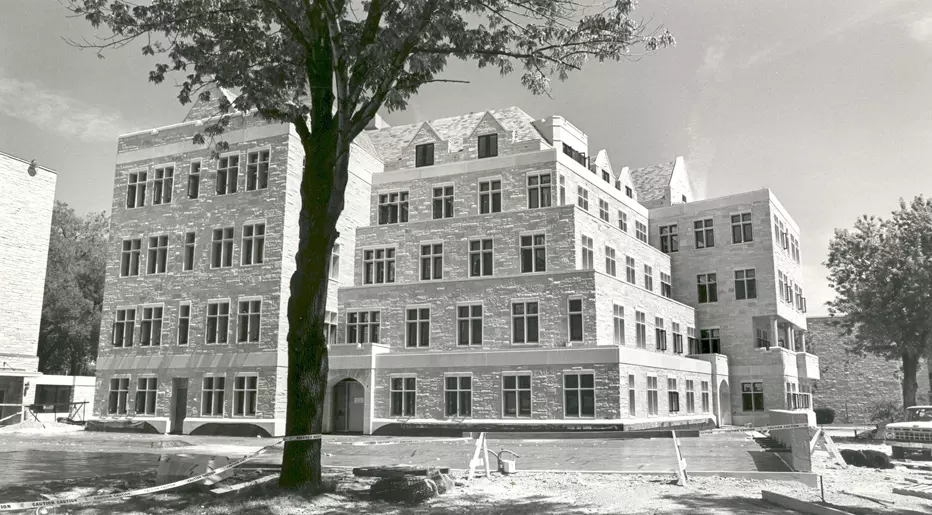 Stranahan Hall, Southwest View
Stranahan Hall, Southwest View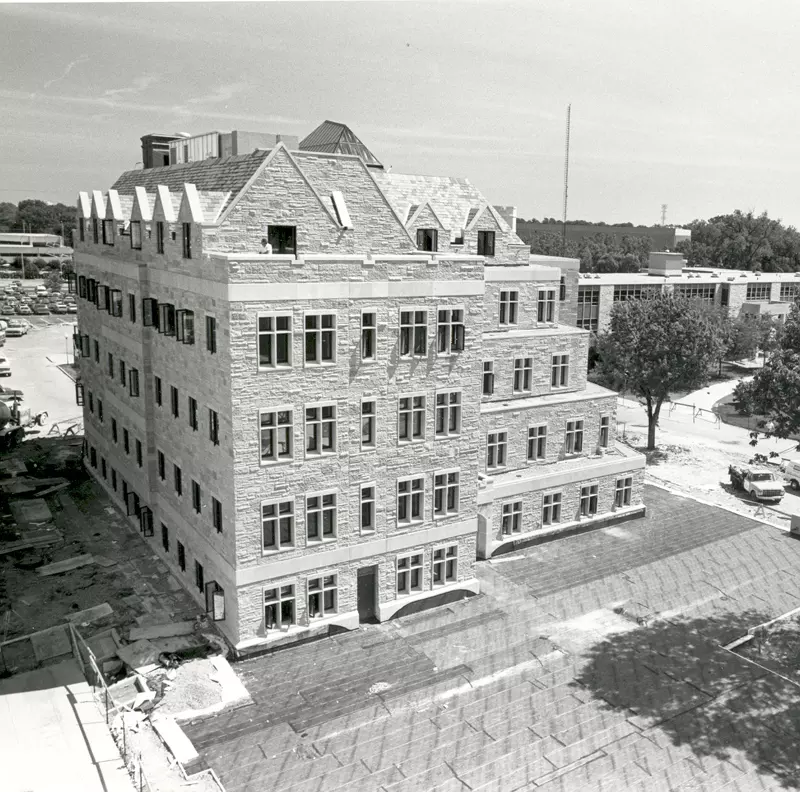 Stranahan Hall, Northwest View
Stranahan Hall, Northwest View
Stranahan Hall, home of the College of Business Administration, fits the Post-Modern label well. It is modern, yet old. It is square, yet round. It is symmetrical, yet asymmetrical. It is eclectic. Stranahan Hall has been one of the most acclaimed buildings constructed on campus. In 1986, the architectural firm won an American Institute of Architects/Society of Honor Award for the design. It has been described as "a sophisticated use of form and materials relating well to the campus's Collegiate Gothic roots."
Features to note:
- Heaviness of walls, unlike sleek glass and steel of the International buildings.
- Pointed dormer windows of the Gothic tradition.
- Rounded northeast corner, balancing against other square and pyramidal sides.
- Classical columns on south facade.
- Pointed arched doorways.
- Five-story atrium, balanced against buried first floor.
- Deeply recessed windows are a much simplified version of the leaded glass casement windows of University Hall.
10. McMaster Hall
Architects: Munger, Munger, and Associates. Date Completed: 1987. Cost: $9 million
McMaster Hall is the second building on campus to be built in the Post-Modern style. Like Stranahan Hall, it encompasses elements of the old and the new, yet its roots are clearly in the Collegiate Gothic. It is less eclectic and more traditional than Stranahan Hall.
Features to note:
- Heaviness of walls gives the feeling of permanence and tradition.
- Pointed roofs and battlement decoration are Gothic elements.
- Pointed arched doorways, chimney brick, casement windows, and slate on roofs are similar to University Hall.
- Seven-story height of central portion reminiscent of University Hall tower.
- Its traditional design contrasts with the building's intended purpose to provide a place for instruction in advanced physics and astronomy.
11. The Academic Center Residence Hall
Architects: Seyfang, Blanchard, Duket, Porter Inc. Date Completed: 1992. Cost: $8.6 million
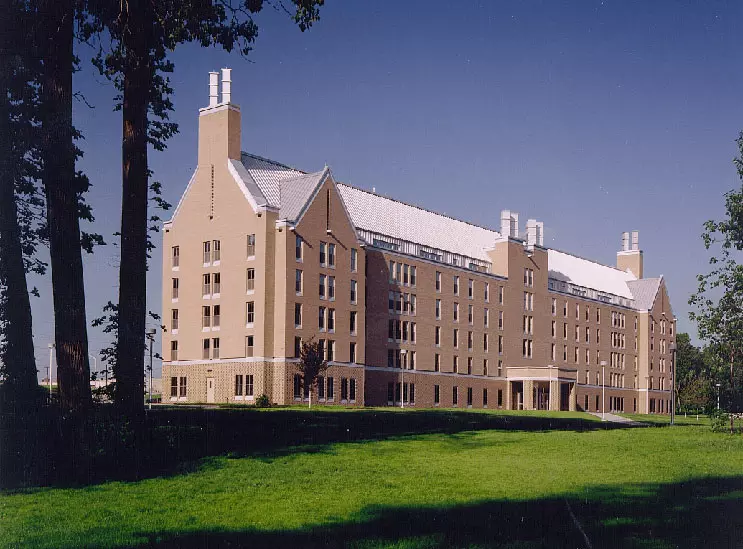 The Academic Center Residence Hall
The Academic Center Residence Hall
Typical of the eclecticism of the Post-Modern movement, the Academic Center Residence Hall combines elements of both the Gothic and International styles of architecture. The outer walls combine modern aluminum with traditional brick. The Hall unites vertical, horizontal and diagonal surface areas, along with tall, narrow windows to provide a unique blend of the old and the new.
Features to note:
- Slanted roofs reminiscent of University Hall design.
- Aluminum roof design combines elements of the old and the new.
12. Student Union Addition
Date Completed: 1994. Cost: $
Much like the Academic Center Residence Hall, the latest Student Union Addition is a combination of the Gothic and International Styles. This is exemplified in the use of both buff-colored brick in the middle of the building and Indiana limestone at each end. This combination is also evident in the design and materials used on the roof, which is peaked and made of slate on each end and flat in the middle.
Features to note:
- Middle of building is rounded showing interest in geometric shapes. This interest is reminiscent of the International as well as the Transitional styles of architecture.
- Ends of building emphasize clean vertical, horizontal, and diagonal lines, and include evidence of the Collegiate Gothic.
13. Center for Visual Arts
Architects: Frank O. Gehry and Associates. Date Completed: 1992. Cost: $10 million
The Center for Visual Arts is located adjacent to The Toledo Museum of Art in Toledo's Old West End and is the first University building designed by world- renowned architect Frank Gehry. The design of the building provides an interesting and pleasing contrast to the classical appearance of the Museum.
The Center for Visual Arts is a building of metal and glass that exemplifies the contemporary style. In designing the complex, Gehry paid special attention to balancing different geometric shapes, particularly noting the flat roof and the rounded corners of the building. The Center for Visual Arts is often noted for its award-winning design and was also featured in Time magazine.
Other Buildings of the Post-Modern Period:
The Greek Village
Architects: Munger, Munger and Associates
Date Completed: 1990
Cost: $7.4 million
Glass Bowl and Larimer Athletic Complex
Glass Bowl Renovation and Larimer Athletic Complex
Architects: Samborn, Steketee, Otis and Evans
Date Completed: 1990
Cost: $18 million
Student Recreation Center
Architects: Hastings and Chivetta
Date Completed: 1991
Cost: $14.1 million
Scott and Tucker Hall Additions
Architects: Seyfang, Blanchard, Duket, Porter Inc.
Date Completed: 1995

